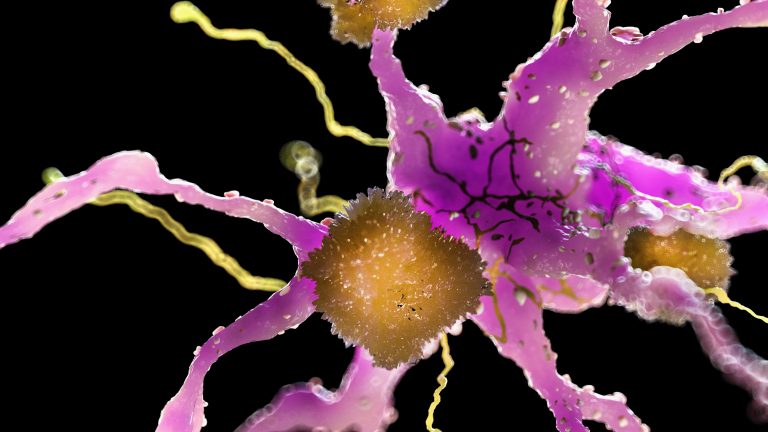
Researchers in Japan have identified a new quality control system that cells use to remove damaged and potentially toxic proteins—including amyloid β (Aβ) that is associated with Alzheimer’s disease (AD)—from the extracellular space. Their studies showed that the chaperone protein Clusterin shuttles misfolded proteins directly into cells for degradation, via cell surface heparan sulfate receptors. The findings could point to new therapeutic targets for disorders such as Alzheimer’s disease and other neurodegenerative diseases, which are associated with the extracellular accumulation of abnormal protein aggregates.
“Clusterin is a type of molecular chaperone that binds to immature proteins to protect them,” commented Eisuke Itakura, PhD, an assistant professor in the department of biology at Chiba University, and first author of the team’s paper in the Journal of Cell Biology. “If we can artificially develop Clusterin that easily binds to amyloid β and inject it into the body, it could be a treatment for Alzheimer’s disease.” Itakura and colleagues Momoka Chiba, PhD, and Akira Matsuura, PhD, reported their findings in a paper titled, “Heparan sulphate is a clearance receptor for aberrant extracellular proteins.”
Protein deposition diseases are associated with the accumulation of abnormal, or misfolded proteins that aggregate together and damage neurons and other cells in the body. Various neurodegenerative diseases, such as AD, Huntington’s disease, Parkinson’s disease, amyotrophic lateral sclerosis, and transmissible spongiform encephalopathies, are all linked with the gradual build-up of misfolded proteins that induce toxicity. To help prevent this damage, cells have developed a range of “elaborate protein quality control systems” that recognize misfolded proteins within cells, and either fold them back into their correct shape or send them to one of the cell’s degradation systems before they start to aggregate. “Thus, the misfolded proteins in cells are almost exclusively targeted via the protein quality control systems to maintain proteostasis,” the authors wrote.
However, said Itakura, “approximately 11% of human proteins exist outside of the cell, where they are subjected to even more stresses that may cause them to misfold. In addition, Alzheimer’s disease, the most prevalent cause of dementia affecting 47.5 million people worldwide, is characterized by aggregates of amyloid β protein in the extracellular space. Despite this, how aberrant extracellular proteins are degraded remains poorly understood.”
Previous studies have proposed that extracellular chaperones stabilize stressed proteins, the authors noted, reasoning that these chaperones may be involved in clearing abnormal extracellular proteins. “The major extracellular chaperone in body fluids of vertebrates is Clusterin, which binds to stressed extracellular proteins … Inspired by the mechanisms of intracellular degradation, we hypothesized that misfolded extracellular proteins may engage chaperone-like proteins that facilitated their degradation through an unidentified cell surface receptor.”
The team’s studies have now identified what they call a “chaperone- and receptor-mediated extracellular protein degradation (CRED) pathway for aberrant extracellular proteins.” Their experiments showed that Clusterin can bind to misfolded extracellular proteins and prevent them from aggregating. Clusterin then effectively escorts these misfolded proteins—including amyloid β—into the cell and delivers them to lysosomes for degradation. Entry of protein-bound Clusterin into the cells is dependent on heparan sulfate proteoglycans receptors, which are present on the surface of almost all human cells. “Here, using a novel quantitative fluorescence assay and genome-wide CRISPR screening, we identified the receptor-mediated degradation pathway by which misfolded extracellular proteins are selectively captured by the extracellular chaperone Clusterin and undergo endocytosis via the cell surface heparan sulfate (HS) receptor,” the team wrote. “The Clusterin-misfolded protein complex directly interacted with HS. The interaction is dependent on electrostatic interactions between positively charged residues on Clusterin and negatively charged sulfate on HS.
Itakura and colleagues found that the Clusterin and heparan sulfate proteoglycan pathway can internalize and degrade a wide variety of misfolded extracellular proteins. “The Clusterin–HS pathway facilitates the degradation of amyloid β peptide and diverse leaked cytosolic proteins in extracellular space,” they stated. “We, therefore, think that this pathway is a general extracellular protein quality control system responsible for the clearance of misfolded proteins from diverse tissues and body fluids,” Itakura said.
Interestingly, mutations in the gene encoding Clusterin have been linked to an increased risk of developing Alzheimer’s disease, and experiments in rodents have shown that injecting Clusterin into the brain can prevent amyloid β-induced neurodegeneration. “Clusterin interacts with oligomeric Aβ to form stable complexes … and several mutations in the Clusterin gene have been identified as a genetic risk association of Alzheimer’s disease,” the team noted. “Our results provide insights into the basic molecular mechanism underlying extracellular proteostasis and provide new avenues for the possible treatment or prevention of diseases associated with aberrant extracellular proteins such as neurodegenerative diseases and autoimmune disease.”
Itakura added, “Our results, therefore, suggest new avenues for the possible treatment or prevention of disorders such as Alzheimer’s disease that are associated with aberrant extracellular proteins.”













